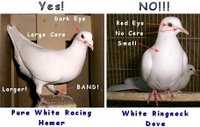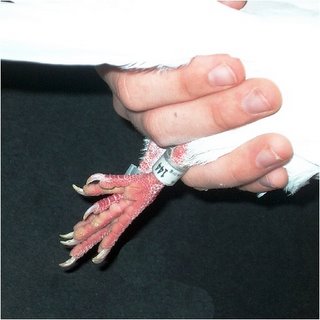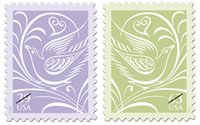
The white dove is the perfect earthly symbol of romantic love. Doves choose a mate, to whom they remain faithful for life! So, as today is Valentine's Day, I'd like to share the courtship of Solomon and Sarah with you.
Here in my office, I keep a lovely pair of pure white fantail pigeons (they look much like fancy doves). These "love doves" are very much in love. "Soloman" and "Sarah" spend most of their days and evenings cuddling up close and dancing a poetic courtship of love.
Each coos to the other in his or her own gentle, passionate language. The male, much like human counterparts, struts with his chest thrust out and spins his dance of love for his lady. In response, the female courtseys to her mate in a gesture of submission, softly, and very subtly fluttering her wings.
They fit their bodies next to each other tightly, innocently, much like cuddling, and "coo" their poetry, communicating a connectedness in a language saved only for a pair in love. They use their beaks to "tickle" one another's faces and necks, each caressing the other with careful preening. Often, he will run his beak along hers and they cradle their heads together, side to side, beaks brushing past each other, in what is nothing less than a passionate kiss.
They take reprieve from this courtship only long enough to take sustanance from seed and grit, and to drink from the water dish. Even this is shared: The male will often share the wealth of the banquet by passing his beak over hers until she is ready. He then opens his beak, she inserts hers, and she "partakes" of the feast, prepared by his loving efforts.
Nest preparing is no less an important ritual in their dance of partnership. In the loft, or in the wild, the male will have chosen a nesting space for the two of them to reside. Nests are reserved only for the rearing of young. At other times, pigeons and doves prefer simply to find a safe place to perch. So nesting is an activity only a mated pair will partake in.
At this time, my lovely fantails have decided to start a family together. The female rests herself in the nesting area. The male's duty is to find suitable nesting materials with which to build their "nursery." As the female patiently sits in the nest, awaiting the arrival of her egg pair, the male takes to the task of furnishing the home.
He chooses from the nesting materials he has available to him, preferring straw, hardy dried grasses, and pine needles. He is careful and selective in the diameter, length, and characteristics of each piece. He chooses only the most suitable, takes the piece up in his beak and carries it to her. One at a time, he presents his find to the female. If she accepts the piece as suitable, she will take it in her beak and will then carefully and systematically place it around her body in the nest. Occasionally a piece will be too long, and they will work as a team to bend it, soften it, shape it a bit, until it becomes more pliable. And occasionally, a piece will simply not suit her at all, and she will shake her head in rejection.
Laughably, the male will sometimes try the same piece again, just to be sure. But her response is usually the same: Not acceptable. In the open loft, males will often "steal" materials from each other while another is off eating, and prances them over to their own nests. Some males have been observed taking their own materials from their own nests, running them around a bit in the loft, and then carrying them back proudly, pretending they've brought something new. The females seem to graciously humor them.
Once the nesting is finished, the birds seem to anxiously anticipate the arrival of their eggs. During this time, they clearly continue their courtship of mutual adoration. However, the male begins "driving" the female around their home with regular timing, helping her prepare her body for laying the eggs. During breaks, they continue "rearranging" the nest materials to make them more and more perfectly suitable for the nestlings to come.
There is more to this story of family rearing, and I will continue the saga in another entry. However, today, on this special "day of love," our focus is all about the beautiful love and courting ritual of these doves. They embody the elements of a strong, passionate, inspiring love -- and all we need to do is mirror their devotion and courtship in order to experience the fullness of loving bliss. Yes, human beings are far, far more complicated. Our communications and life-circumstances offer hindrances and barriers the birds do not have to face. And yet, they've got it so right -- and must it really be so complex as we make it? At least on these days in which we celebrate love, doves are the perfect reminder of what is required to make a relationship fulfilling:
- unconditional love
- respect
- devotion
- fidelity
- affection
- adorning one another with approval
- verbal praise
- trustworthiness
- servanthood
- teamwork
 ONLY CAREFULLY TRAINED, PERMANENTLY BANDED, PURE WHITE HOMING PIGEONS should ever be released, and only within the area and mileage limits of their training/service area. Yes, homing pigeons "home," but only with thorough and careful training. They have the ability, the trainers must help them hone it, and properly condition them for flights of length.
ONLY CAREFULLY TRAINED, PERMANENTLY BANDED, PURE WHITE HOMING PIGEONS should ever be released, and only within the area and mileage limits of their training/service area. Yes, homing pigeons "home," but only with thorough and careful training. They have the ability, the trainers must help them hone it, and properly condition them for flights of length.













